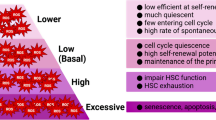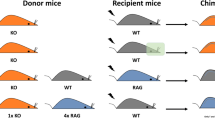Abstract
Durable transplantation tolerance can be reliably achieved by inducing engraftment of hematopoietic cells in recipients initially depleted of T-lymphocytes. Engraftment of donor pluripotent hematopoietic stem cells (PPHSC) produces mixed hematopoietic chimeras in which both host and donor cells coexist and are tolerant of each other. The major mechanism of tolerance in these chimeras is central, intrathymic clonal deletion, which is induced and maintained by immigration of both host and donor marrow-derived cells to the host thymus, ensuring the ongoing central deletion of donorand host-reactive cells. In this article, approaches developed in our laboratory to induce stable mixed hematopoietic chimerism and specific central deletional allogeneic and xenogeneic tolerance without toxic or myeloablative host conditioning are reviewed.
Similar content being viewed by others
References
Gjertson DW: Survival trends in long-term first cadaver-donor kidney transplants; in Terasaki PI, Cecka JM (eds): Clinical Transplants 1991. UCLA 1991. LosAngeles,CA, UCLA Tissue Typing Laboratory, 1991, pp 225–235.
Rocken M, Urban JF, Shevach EM: Infection breaks T cell tolerance. Nature 1992;359:79–82.
Migita K, Ochi A: The fate of anergic T cells in vivo. J Immunol 1993; 150:763–770.
Ramsdell F, Fowlkes BJ: Maintenance of in vivo tolerance by persistence of antigen. Science 1992;257:1130–1134.
Morecki S, Leshem B, Eid A, Slavin S: Alloantigen persistence in induction and maintenance of transplantation tolerance. J Exp Med 1987; 165:1468–1480.
Qin S, Cobbold S, Benjamin R, Waldmann H: Induction of classical transplantation tolerance in the adult. J Exp Med 1989; 169:779–794.
Cobbold SP, Qin S, Waldmann H: Reprogramming the immune system for tolerance with monoclonal antibodies. Sem. Immunol 1990; 2:377–387.
Laufer MT, DeKoning J, Markowitz SJ, Lo D, Glimcher LH: Unopposed positive selection and autoreactivity in mice expressing class IIMHC only on thymic cortex. Nature 1996; 383:81–85.
Burkly L, Hession C, Ogata L, Reilly C, Marconi AL, Olson D, Tizard R, Cate R, Lo D: Expression of relB is required for the development of thymic medulla and dendritic cells. Nature 1996;373:53l-536.
Brocker T, Riedinger M, Karjalainen K: Targeted expression of major histocompatibility complex (MHC) demonstrates that dendritic cells can induce negative but not positive selection in vivo. J Exp Med 1997; 185:541–550.
van Ewijk W, Ron Y, Monaco J, Kappler J, Marrack P, Le Meur M, Gerlinger P, Durand B, Benoist C, Mathis D: Compartmentalization of MHC class II gene expression in transgenic mice. Cell 1988;53:357–370.
Ramsdell F, Fowlkes BJ:Clonaldeletion versus clonal anergy: the role of the thymus in inducing self tolerance. Science 1990;248:1342–1348.
Main JM, Prehn RT: Successful skin homografts after the administration of high dosage X radiation and homologous bone marrow. J Natl Cancer Inst 1955;15:1023–1028.
Singer A, Hathcock KS, Hodes RJ: Self recognition in allogeneic radiation chimeras. A radiation resistant host element dictates the self specificity and immune response gene phenotype of T-helper cells. J Exp Med 1981; 153:1286–1301.
Zinkernagel RM, Callahan GN, Althage A, Cooper S, Klein PA, Klein J: On the thymus in the differentiation of “H-2 selfrecognition” by T cells: evidence for dual recognition? J Exp Med 1978;147:882–896.
Ildstad ST, Wren SM, Bluestone JA, Barbieri SA, Sachs DH: Characterization of mixed allogeneic chimeras. Immunocompetence, in vitro reactivity, and genetic specificity of tolerance. J Exp Med 1985;162:231–244.
Zinkernagel RM, Althage A, Callahan G, Welsh RM Jr.: On the immunocompetence of H-2 incompatible irradiation bone marrow chimeras. J Immunol 1980; 124:2356–2365.
Ruedi E, Sykes M, Ildstad ST, Chester CH, Althage A, Hengartner H, Sachs DH, Zinkernagel RM: Antiviral T cell competence and restriction specificity of mixed allogeneic (P1 + P2 → P1) irradiation chimeras. Cell Immuol 1989;121:185–195.
Marrack P, Lo D, Brinster R, Palmiter R, Burkly L, Flavell RH, Kappler J: The effect of thymus environment on T cell development and tolerance. Cell 1988;53:627–634.
Ramsdell F, Lantz T, Fowlkes BJ: A nondeletional mechanism of thymic self tolerance. Science 1989;246:1038–1041.
Nikolic B, Sykes M: Clonal deletion as a mechanism of transplantation tolerance. J Heart Lung Transplant 1996;15:1171–1178.
Sharabi Y, Sachs DH: Mixed chimerism and permanent specific transplantation tolerance induced by a non-lethal preparative regimen. J Exp Med 1989;169:493–502.
Tomita Y, Khan A, Sykes M:Role of intrathymic clonal deletion and peripheral anergy in transplantation tolerance induced by bone marrow transplantation in mice conditioned with a non-myeloablative regimen. J Immunol 1994;153:1087–1098.
Sharabi Y, Abraham VS, Sykes M, Sachs DH: Mixed allogeneic chimeras prepared by a nonmyeloablative regimen: requirement for chimerism to maintain tolerance. Bone Marrow Transplant 1992;9:191–197.
Khan A, Tomita Y, Sykes M: Thymic dependence of loss of tolerance in mixed allogeneic bone marrow chimeras after depletion of donor antigen. Peripheral mechanisms do not contribute to maintenance of tolerance. Transplantation 1995;62:380–387.
Tomita Y, Lee LA, Sykes M: Engraftment of rat bone marrow and its role in negative selection of murine T cells in mice conditioned with a modified non-myeloablative regimen. Xenotransplantation 1994; 1:109–117.
Lee LA, Sergio JJ, Sykes M: Natural killer cells weakly resist engraftment of allogeneic longterm multilineage-repopulating hematopoietic stem cells. Transplantation 1996;61:125–132.
Lee LA, Sergio JJ, Sykes M: Evidence for non-immune mechanisms in the loss of hematopoietic chimerism in rat→mouse mixed xenogeneic chimeras. Xenotransplantation 1995;2:57–66.
Sharabi Y, Aksentijevich I, Sundt III TM, Sachs DH, Sykes M: Specific tolerance induction across a xenogeneic barrier: production of mixed rat→mouse lymphohematopoietic chimeras using a nonlethal preparative regimen. J Exp Med 1990;172:195–202.
Lee LA, Sergio JJ, Sachs DH, Sykes M: Mechanism of tolerance in mixed xenogeneic chimeras prepared with a non-myeloablative conditioning regimen. Transplant Proc 1994;26:1197,1198.
Aksentijevich I, Sachs DH, Sykes M: Normal mouse serum contains natural antibody against bone marrow cells of a concordant xenogeneic species. J Immunol 1991;147:79–85.
Aksentijevich I, Sachs DH, Sykes M: Humoral tolerance in xenogeneic BMT recipients conditioned with a non-myeloablative regimen. Transplantation 1992;53:1108–1114.
Gritsch HA, Sykes M:Hostmarrow has a competitive advantage which limits donor hematopoietic repopulation in mixed xenogeneic chimeras. Xenotransplantation 1996;3:312–320.
Tomita Y, Sachs DH, Sykes M: Myelosuppressive conditioning is required to achieve engraftment of pluripotent stem cells contained in moderate doses of syngeneic bone marrow. Blood 1994;83:939–948.
Ramshaw HS, Crittenden RB, Dooner M, Peters SO, Rao SS, Quesenberry PJ: High levels of engraftment with a single infusion of bone marrow cells into normal unprepared mice. Biol Blood Marrow Transplant 1995; 1:74–80.
Bachar-Lustig E, Rachamin N, Li H-W, Lan F, Reisner Y: Megadose of T cell-depleted bone marrow overcomes MHC barriers in sublethally irradiated mice. Nature Med 1995;1:1268–1273.
Aversa F, Tabilio A, Terenzi A, Velardi A, Falzetti F, Gionnoni C, Iacucci R, Zei T, Martelli MP, Gambelunghe C, Rossetti M, Caputo P, Latini P, Aristei C, Raymondi C, Reisner Y, Martelli MF: Successful engraftment of T-cell-depleted haploidentical “three-loci” incompatible transplants in leukemia patients by addition of recombinant human granulocyte colony-stimulating factor-mobilized peripheral blood progenitor cells to bone marrow inoculum. Blood 1994; 84:3948–3955.
Sykes M, Szot GL, Swenson KA, Pearson DA: Induction of high levels of allogeneic hematopoietic reconstitution and donor-specific tolerance without myclosupressive conditioning. Nat Med 1997;3:783–788.
Sykes M, Szot GL, Swenson K, Pearson DA, Wekerle T: Seperate regulation of peripheral hematopoietic and thymic engraftment. Exp Hematol, in press.
Tomita Y, Khan A, Sykes M: Mechanism by which additional monoclonal antibody injections overcome the requirement for thymic irradiation to achieve mixed chimerism in mice receiving bone marrow transplantation after conditioning with anti-T cell mAbs and 3 Gy whole body irradiation. Transplantation 1996;61:477–485.
Tomita Y, Sachs DH, Khan A, Sykes M: Additional mAb injections can replace thymic irradiation to allow induction of mixed chimerism and tolerance in mice receiving bone marrow transplantation after conditioning with antiT cell mAbs and 3 Gy whole body irradiation. Transplantation 1996; 61:469–477.
Sykes M, Chester CH, Sundt TM, Romick ML, Hoyles KA, Sachs DH: Effects of T cell depletion in radiation bone marrow chimeras: III. Characterization of allogeneic bone marrow cell populations that increase allogeneic chimerism independently of graftvs-host disease in mixed marrow recipients. J Immunol 1989; 143: 3503–3511.
Jenkins MK, Schwartz RH, Pardoll DM: Effects of Cyclosporine A on T cell development and clonal deletion. Science 1988;241:1655–1658.
Gao E-K, Lo D, Cheney R, Kanagawa O, Sprent J: Abnormal differentiation of thymocytes in mice treated with cyclosporin A. Nature 1988;336:176–179.
Urdahl KB, Pardoll DM, Jenkins MK: Cyclosporin A inhibits positive selection and delays negative selection in αβ TCR transgenic mice. J Immunol 1994;152:2853–2859.
Liu J: FK506 and cyclosporin, molecular probes for studying intracellular signal transduction. Immunol Today 1993; 14:290–295.
Beschorner WE, Yao X, Divic J: Recruitment of semiallogeneic dendritic cells to the thymus during post-Cyclosporine thymic regeneration. Transplantation 1995;60: 1326–1330.
Yang Y-G, Sergio JJ, Swenson K, Glaser RM, Monroy R, Sykes M: Donor-specific growth factors promote swine hematopoiesis in SCID mice. Xenotransplant 1996; 3:92–101.
Lee LA, Gritsch HA, Sergio JJ, Arn JS, Glaser RM, Sablinski T, Sachs DH, Sykes M: Specific tolerance across a discordant xenogeneic transplantation barrier. Proc Natl Acad Sci USA 1994; 91:10,864–10,867.
Zhao Y, Swenson K, Sergio JJ, Arn JS, Sachs DH, Sykes M: Skin graft tolerance across a discordant xenogeneic barrier. Nature Med 1996;2:1211–1216.
Bradley SM, Kruisbeek AM, Singer A: Cytotoxic T lymphocyte response in allogeneic radiation bone marrow chimeras. The chimeric host strictly dictates the self-repertoire of Ia-restricted T cells but not K/D-restricted T cells. J Exp Med 1982;156: 1650–1663.
Geha RS, Rosen FS: The evolution of MHC restrictions in antigen recognition by T cells in a haploidentical bone marrow transplant recipient. J Immunol 1989; 143: 84–88.
Chu E, Umetsu D, Rosen F, Geha RS: Major histocompatibility restriction of antigen recognition by T cells in a recipient of haplotype mismatched human bone marrow transplantation. J Clin Invest 1983;72:1124–1129.
Marken LM, Kostyu DD, Ward EF, McLaughlin MT, Watson JT, Buckley HR, Schiff ES, Ungerleider MR, Gaynor WJ, Oldham TK, Mahaffey MS, Ballow M, Driscoll AD, Hale PL, Haynes FB: Successful formation of a chimeric human thymus allograft following transplantation of cultured postnatal human thymus. J Immunol 1997; 158:998–1005.
Zhao Y, Fishman JA, Sergio JJ, Oliveros JL, Pearson DA, Szot GL, Wilkinson RA, Arn JS, Sachs DH, Sykes M: Immune restoration by fetal pig thymus grafts in T celldepleted, thymectomized mice. J Immunol 1996;158:1641–1649.
Mackall CL, Fleisher TA, Brown MR, Andrich MP, Chen CC, Feuerstein IM, Horowitz ME, Magrath IT, Shad AT, Steinberg SM, Wexler LH, Gress RE: Age, thymopoiesis, and CD4+ T-lymphocyte regeneration after intensive chemotherapy. N Engl J Med 1995;332: 143–149.
Annett G, Weinberg K, Kashyap A, Chan R, Lenarsky C, Forman S, Parkman R: Post-transplantation thymic function predicts immunocompetence. Blood 1994;84:250a (abstract).
Muller-Hermelink HK, Sale GE, Borisch B, Storb R: Pathology of the thymus after allogeneic bone marrow transplantation in man. A histologic immunohistochemical study of 36 patients. Am. J. Pathol. 1987;129:242–256.
Hong R, Santosham M, Schulte-Wisserman H, Horowitz S, Hsu SH, Winkelstein JA: Reconstitution of B and T lymphocyte function in SCID after transplantation with thymic epithelium. Lancet 1972; 2:1270–1272.
Hong R, Moore AL: Organ culture for thymus transplantation. Transplantation 1996;61:444–448.
Kawai T, Cosimi AB, Colvin RB, Powelson J, Eason J, Kozlowski T, Sykes M, Monroy R, Tanaka M, Sachs DH: Mixed allogeneic chimerism and renal allograft tolerance in cynomologous monkeys. Transplantation 1995;59: 256–262.
Bartholomew A, Cosimi AB, Sachs DH, Bailin A, Boskovic S, Colvin R, Hong H, Johnson M, Kimikawa M, Meehan S, Sablinski T, Wee SL, Powelson J: A study of tolerance in a concordant xenograft model. Transplant Proc 1996;29:923,924.
Author information
Authors and Affiliations
Rights and permissions
About this article
Cite this article
Nikolic, B., Sykes, M. Mixed hematopoietic chimerism and transplantation tolerance. Immunol Res 16, 217–228 (1997). https://doi.org/10.1007/BF02786391
Issue Date:
DOI: https://doi.org/10.1007/BF02786391




